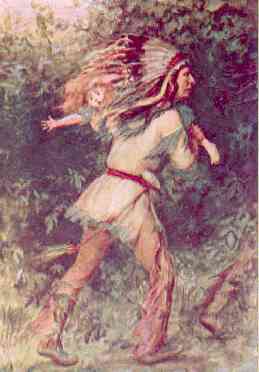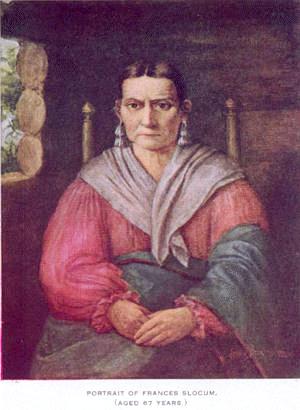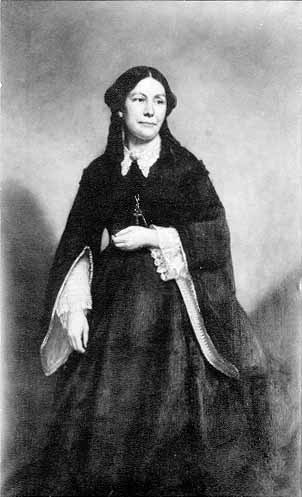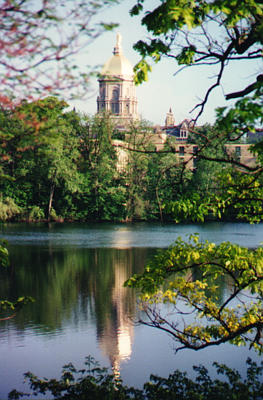
A Cave of Candles / by Dorothy V. Corson

Chapter 15a
A Gem of a Story

The more I learned about the Ewing name the more it seemed to be triggering something in my memory. Where had I read of that name before? Several days went by and then one morning the buried memory surfaced. It suddenly dawned on me that it had something to do with Frances Slocum the earlier mentioned ancestor of a member of the Kintz family, the little four year old girl who had been stolen by the Indians.
The Kintz genealogy, which included the genealogy of the Slocum who married into their family, reports that the Slocums are listed in the Mayflower descendants index book. There is a wealth of history in their genealogy which tells of a Slocum River near Buzzards Bay named after the family.
Recently, I saw this announcement to the students in an 1872 Scholastic: "Mrs. Slocum's Boarding House will be opened sometime after Easter." It prompted me to check the Notre Dame student records where I also found an entry for a Leroy Slocum for 1864-65 school year. I wondered if they might also have been descendants of the Frances Slocum family.
After the capture of Frances, she was adopted and raised by a Delaware Indian family to take the place of their dead daughter. She was named Maconaquah after her. When the tribe was moved west to Indiana by the government, she and her Indian family lived along the river near Peru, Indiana, on what is now known as the Frances Slocum Trail. It was there she was located by her white family, in her sixties, living a comfortable and respected life among the Indians. Through an interpreter, she told them that she had been too long an Indian to leave her tribal home but she would welcome visits from them. This she did until her death in 1847 at the age of seventy-four.
Ross F. Lockridge's description of Frances Slocum bears sharing:
She eschewed the trammels of civilized life and could only breathe freely in the great unfenced outdoors, which God gave to the Red Man. They called her Ma-con-a-qua (Female Lion or Little Bear Woman) because she was so strong and swift.(178)
I had retraced my steps on other items of my search, perhaps this one also warranted a second look-see. I returned to the library for a copy of Frances Slocum, The Lost Sister of Wyoming, which contained the family letters and papers pertaining to her life among the Indians during her sixty year captivity.
I was amazed the first time I read the book and doubly impressed upon my second reading. Had not a Grandniece compiled, written and published this wonderful story for her children and grandchildren, it would have been lost forever.
Wyoming referred to a beautiful secluded valley nestled amid the Pennsylvania mountains, where Frances' story began in 1773 and where forty days later her father and grandfather were killed by an Indian war party:
Thus in little more than a month her mother had lost a beloved child, carried into captivity; an inmate of the family had been cruelly murdered; two others of the household had been taken prisoners; and now her husband and her father were dead.
Sixty-four years later, after a fruitless search by the Slocum family, Frances Slocum was found, in a most extraordinary way, by a Colonel George Ewing. Now I knew why that name had registered on my mind previously. The following brief poem chronicles that search:
|
The Fruitless Search They searched through many a forest wild, -- Todd |
It was 1835 when Colonel Ewing entered the picture. This would have been the same year Badin turned over his land at Ste. Marie des Lacs to Bishop Brute:
It was nearly sixty years since little Frances had been captured by the Indians. Two generations of men had passed away and no tidings had been heard of her. The mother had gone down to the grave, ever mourning for her lost one; the brothers and sisters had become aged, only four were known to be living of a large family, and all hope of ever hearing of Frances had passed away.
A gentleman connected with the Indian trade, and also with the public service of the country, in traversing a remote section of Indiana [near Peru], was overtaken by night while at a distance from the abode of civilized man. When it became too dark for him to pursue his way, he sought an Indian habitation, and was fortunate to find shelter and welcome in one of the better sort. The proprietor of the lodge was indeed opulent for an Indian -- possessing horses and skins, and other comforts in abundance. He was attracted in the course of the evening by the appearance of the venerable mistress of the lodge, whose complexion was lighter than that of her family, and as glimpses were occasionally disclosed of her arm beneath her blanket-robe, he saw it was white. She seemed aged, and at that time very infirm; and was greatly revered by the household. He noticed her hair, and its fineness and softness convinced him that she could not be an Indian. As soon as the family had become still, or had retired, he began to converse with her, and at once was greatly interested in her. At her request, and, as he supposed, because she thought she had but a short time to live, she gave him the history of her life. She was not an Indian. She told him that, when a little girl, she had been captured by the Indians, had been adopted by them [an Indian Chief] and had never lived with the white people since. In the course of her statement she mentioned that her family name was Slocum, and her father a Quaker, and that she had been stolen from somewhere in the valley of the Susquehanna. But of circumstances calculated to throw light upon her early history, she could remember no more. She did not remember her name and could not speak her mother tongue. Colonel Ewing conversed with her in Miami tongue, which he understood. In the morning Colonel Ewing mounted his horse and prepared to set out on his journey for Logansport. He bade the old lady and family farewell with much feeling. In accordance with Indian customs, they refused to receive any compensation for their hospitality. On Colonel Ewing's return to his own home, he related the adventure to his mother, who, with the just feelings of a woman, urged him to take some measure to make the discovery known, and at her solicitation he was induced to write a narrative of the case, which he addressed to the postmaster at Lancaster, Pa., as that seemed the largest town near the Susquehanna River, with a request that it might be published in some Pennsylvania newspaper.
He mentions in particular her telling him she had something on her mind: I am old and weak. I shall not live long, and I must tell it. I cannot die in peace if I do not." Still, he said she did not reveal what was on her mind. At last he said he told her she could reveal it to him at another time. "No, no," she replied, "I may die, I may die; and then I will have no rest in the Spirit World!" she said. Had she not been in such a fragile condition, it is unlikely she would have told him her story and she never would have been found.
His interesting letter, dated January 20, 1835, is included in this extraordinary book. It describes in more detail her remembrances of her Quaker family and her capture, her surroundings and her past life with the Indians. She had four children and three grandchildren, two sons who died and two daughters who lived with her. Her eldest granddaughter who had died three years before, was poisoned by the son of a chief who wanted to marry her. "Her parents would not consent, as he was a drunken, worthless Indian, and as they always seek revenge, it ended in her death."
When the letter reached its destination, the story continues:
The postmistress, strange as it may seem, took no interest in the letter, throwing it aside, and it lay for two years among a lot of old papers and letters which were deemed worthless. At last, in examining these papers the letter was found by one who appreciated it, and given to the young new owner of the Intelligencer, John W. Forney. With his journalistic instinct Mr. Forney at once saw its importance and published it [two and a half years later] in the issue of August, 1837.

In September of 1837, Frances Slocum, known as "White Rose of Miami" adopted by an Indian chief and the widow of a chief, was reunited with her surviving family, a sister and three brothers. She was positively identified by a bruised finger where her little brother had accidentally "hammered off her fingernail." Though she welcomed her relatives the rest of her life, she chose to stay with her Indian family:
I am an old tree. I cannot move about; I was a sapling when they took me away. It is all gone past. I am afraid I should die and never come back. I am happy here. I shall die here and lie in that graveyard, and they will raise the pole at my grave, with the white flag on it, and the Great Spirit will know where to find me . . . .(179)
Martha Phelp's book about her great Aunt is more than worth the reading in its entirety and I urge anyone who is moved by this story to do so.
I include the above excerpts not only because it is an extraordinary story but also because it illustrates, once again, the strange, twists and turns our lives take in fulfilling our destiny. In a dense forest, in the darkness of the night, two lives were crossed that would change history for Frances Slocum and her Indian descendants. Through the efforts of the Slocum family and Colonel Ewing they would be allowed to retain their 640 acres while the other Indians were moved westward. Frances Slocum died on March 9, 1847, at the age of 74, 12 years after Colonel George Ewing's path crossed hers. It is said that we cannot control the events in our lives but we can control how we react to them. Her saga is a stirring example of the axiom, what goes around comes around.
I came upon another example of that axiom, on the same Indian subject, in the University Archives in studying Ellen Ewing's letters and papers. I found a scrapbook entitled: Ellen (Ewing) Sherman's Scrapbook -- Indian Missions. It is a very interesting study of the removal times and the effort of another Ewing, Ellen Sherman, in behalf of the Indians.

The scrapbook is filled with yellowed newspaper articles she collected on a subject she felt very strongly about. It also includes her passionate feelings about the goings on at the time. She speaks of the money collected by the Bureau of Catholic Indian Missions which was given by generous Catholics "to the poor persecuted and suffering Indians" and she agrees with the writer of one article. "Which is the worse offender, the U. S. Government which by treaty guarantees to the Indians certain lands and then drives them off; or the Bureau of Catholic Missions, which collects money for the spiritual necessities of the same Indians and spends 9/10 of it on salaries and furniture, etc."
She is outraged by a proposal being enacted into law at the time, "to parcel out the Indians, as if they were dumb cattle, among various bodies of religionists given certain districts or reservations to one, or other Religion, with exclusive control. The very plan was horrible. It was a violation of the first principles of natural justice. It was also an outrage on the Constitution of the United States. This Bogus Bureau is a nuisance -- an obstruction to paying the debt Americans owe to the poor Indians." She then states that some general plan should be adopted . . . " to atone for the wrongs our people, Catholics and non-Catholics, have as a people done to the Indians. Give the Indians their pensions honestly and let the Indian, like the white people choose their religion." "We have wronged the Indians. We owe them reparation. If we do not render it God will visit it in judgment on us, or on our posterity, on this soil."(180) Her last statement written in those sad times for the Indians, echos over all the years from then to now, when native Americans are just beginning to be heard.
For centuries to come Col. George Ewing's name will be blended with that of Frances Slocum as the Gillespie, Ewing and Sherman names are blended with the history of Notre Dame and St. Mary's. Both of these Ewing families shared a common ancestor. They were distantly related.(181)
More Campus Connections -- Mount St. Vincent-on-the-Hudson
The Notre Dame and St. Mary's connections were continuing to grow. That always changing river of humanity was continuously flowing through an almost changeless natural setting. People would come and go but the campus would retain its natural beauty and ageless heritage.

Long before the Grotto appeared on the scene, Badin spoke of Our Lady's growing influence on campus:
The blessed Virgin watches from the golden dome on high beside the beautiful little lake, under the shadow of the great institution named in her honor. For mother-like the inspiration of her faith heals the troubled mind.(182)
Encouraged by those long ago thoughts, I waded into more early history books. Why I had been drawn to the Ewing and Sherman names and their association with both Notre Dame and St. Mary's soon became evident. Once again the Grotto entered the pictured.
St. Aloysius Parish in Washington, D.C., St. Mary's Academy at Notre Dame, and the Sisters of Charity at Yonkers on the Hudson, were listed as the only three Grottoes in the United States during the mid 1870s. All three appeared to have existed at approximately the same time.
After the war, in the early 1870s, Ellen Ewing Sherman was closely associated with Washington, D.C. and a benefactor of the Sisters Of Notre Dame at the St. Aloysius Parish. From 1872-1873, Minnie Sherman, their daughter, and a former student at St. Mary's, spent a year abroad, where she visited for some time at Lourdes, France and wrote home at length about it. 1873 was also the same year Mother Angela visited Lourdes and ordered the statues for the indoor St. Mary's Grotto.
It seemed a curious coincidence. However, Ellen Ewing Sherman and Mother Angela, though now separated by some distance, would still have been in close contact with one another through Ellen's daughters, who were students at St. Mary's. Could Minnie's trip to Lourdes, and the building of a Lourdes Grotto by Mother Angela upon her return, inspired Ellen to foster one at her parish, St. Aloysius, at about the same time?
A number of years before, I had become acquainted with a Sister of Notre Dame de Namur, whose sister is a near neighbor of mine. When Sister Mary Godfrey spent her yearly "home visit" with her sister we always connected for an afternoon of conversation at least once during her visit. Now, I wondered if she might be connected with St. Aloysius or might know about this early Grotto, its origin, and whether it still existed. Knowing there might be many Sisters of Notre Dame orders, the possibility of her being connected with this one seemed highly unlikely. Even so, I felt it was another of those questions worth asking. Soon after her arrival, I had an opportunity to ask her about it and was surprised to learn that, indeed, it was her Mother House and she loved the Grotto dearly.
Ellen Ewing, she said, was very much a part of the St. Aloysius parish during her years in Washington, D.C., during the 1870s. She said it was she who asked the convent to take in freed slave girls from the south and teach them skills to support themselves after the war. She did not know if there was a connection between Ellen Ewing and the Grotto but felt there could have been.
As a young nun, she said she made morning and evening stops at the Grotto each day and derived great comfort from it being there. When I asked her if it still existed she told me that unfortunately both St. Aloysius Parish and the Grotto were gone now. The government had given them the assurance that their parish land would not be taken for government buildings but they did not keep their word and the parish and Grotto were no more.
She was from the House of the Sisters of Notre Dame and her sister, Kathy, and her husband, Stan Farmann, were a longtime law librarian team at Notre Dame, now retired. I very nearly didn't ask her because the de Namur on the name of her order seemed to suggest she would not be connected with them. She smiled and explained that the names of the country the order stemmed from were often added to their title although they were all of the same Notre Dame order.
I had not anticipated getting firsthand information in such an unexpected way. Almost without exception, it seemed every lead I'd followed had a connection with Notre Dame. It appears that the Hickey family adage might also apply to Notre Dame. Stand on a corner long enough and you'll meet someone related to the Notre Dame Family.
Now, I began to wonder if the third Grotto mentioned, the House of the Sisters of Charity at Yonkers on the Hudson, would also be gone. I gave it only a passing thought and went on with my daily research. In this case, I had decided to take a cursory look at Notre Dame's Ave Maria publication during the middle 1870s for any additional information about Father Sorin's Grotto similar to what I'd lately found in the Scholastics about the early one at St. Mary's.
The contents of the Ave Maria for those years revealed no information published at the time. However, two volumes, 1874 and 1875, the ones I most wanted to see were missing from the library stacks. This meant a trip back to the microfilm department to check them on film. The table of contents in one of them mentioned a new Grotto being dedicated. Thinking they were referring to the St. Mary's Grotto, I felt my time had not been wasted. However, when I got to the page listed, I discovered to my surprise an appealing lengthy description, not of the St. Mary's Grotto, but of the third 1870s Grotto mentioned earlier, the Sisters of Charity at Yonkers on the Hudson.
In view of the main road is a lake or pond fed by the numerous streams in the vicinity. In the center of the lake is a small island upon which has been built a cave or grotto in imitation of that of Lourdes; and although it resembles a classic old ruin rather than a veritable production of nature, still it is picturesquely beautiful. The island is reached by rustic bridges which connect with the main land; then the pilgrim passes under a quaintly-fashioned and somewhat irregular archway, and is immediately in front of the Grotto . . . the wild beauty and calm stillness of the surrounding scenery serving to deepen the impression.(183)
I tried to picture this Grotto on an island, in a pond, with a bridge leading to it and found myself wishing I were close enough to view it in person. I made a note of the date and thought no more about it.
Several days later, in mentioning it to Rita Erskine, my Rare Books friend at the Hesburgh Memorial Library, she told me the Sisters Of Charity(184) was founded by Mother Seton, the first American Catholic convert made a Saint. She went on to explain that both the Rare Books and Special Collections and the University of Notre Dame Archives had a number of articles and papers given to them by the grandson of Mother Seton, Archbishop Robert Seton. Several Sisters from the order, she said, came to the University yearly to view her prayer book and her Bible, to kiss it, and say a prayer over it. In checking it out, I also found a Spanish painting(185) in the University Archives given to Mother Seton by her husband in the early 1800s before he died. The gold paint is worn on the bottom of the frame where Mother Seton kissed it every day and sometimes twice a day.
I began to wonder if it might be worth writing to the Sisters of Charity to ask if their Grotto was still in existence. I wasn't sure I had the right address but sent my letter anyway asking them to forward it to their archivist. I mentioned the article in the Ave Maria and offered to send them a copy if they did not already have one.
Within a week, I received a reply from the archivist, Sister Rita King, at the Sisters of Charity Center at Mt. St. Vincent-on-Hudson; a large manila envelope in which were a dozen papers, among them several Xerox photographs of the 1870s Grotto at the time it was built. I smiled to myself as I read her letter:
Your letter asking for information about the Grotto of Our Lady of Lourdes on our property set me off to research a Grotto I always took for granted. Judging from the material I was able to find, you may know more about it than we do.(186)
It was time put to good use, my letter had also put her in a wondering mode inspiring her to hunt through their own records. I made a copy of the Ave Maria article, told her of the additional Seton items at the University and added copies of several other articles I thought might interest her.
Their Grotto may now have a special distinction. It could be the oldest in America and the only one of the three still in existence. The web of information I'd been weaving was widening becoming ever more intricate and interesting. Along with it, I was enlarging my own scope of information and knowledge and hopefully adding to that of others along the way.
Two years later I received an article from the Sisters of Charity archivist entitled, "Place of Beauty: Grotto at Mount St. Vincent lays claim to being the oldest in United States." She explained that after my letter arrived there was a renewed interest in their Grotto. That summer a fountain was added to the pond and an accompanying clean-up was begun to restore the site to its original beauty. All of which, resulted in the article with its color cover and a beautiful centerfold article about their Grotto. In it, they mentioned how the claim of the grotto's seniority had surfaced when my letter of research material arrived.